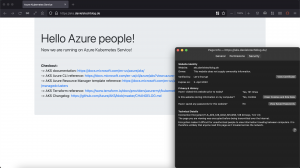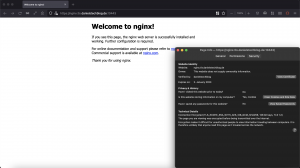The Istio ingress gateway supports two modes for dealing with TLS traffic: TLS termination and TLS passthrough.
Running Istio with TLS termination is the default and standard configuration for most installations. Incoming TLS traffic is terminated at the Istio ingress gateway level and then sent to the destination service encrypted via mTLS within the service mesh.
Having the TLS passthrough configured the Istio ingress gateway passing through the TLS traffic directly to the destination service which then does the TLS termination.
Are both modes supported at the same time with the default ingress gateway configuration?
Sure, and that is today’s topic in this blog post.
Configuration – Istio ingress gateway
Our starting point is a standard Istio installation and ingress gateway configuration doing the TLS termination on port 443 for our wildcard domain configuration.
apiVersion: install.istio.io/v1alpha1
kind: IstioOperator
metadata:
namespace: istio-system
name: istiocontrolplane
spec:
components:
base:
enabled: true
cni:
enabled: true
ingressGateways:
- enabled: true
name: istio-ingressgateway
k8s:
hpaSpec:
minReplicas: 2
overlays:
- apiVersion: v1
kind: Service
name: istio-ingressgateway
patches:
- path: spec.ports
value:
- name: status-port
port: 15021
targetPort: 15021
protocol: TCP
- name: http2
port: 80
targetPort: 8080
protocol: TCP
- name: https
port: 443
targetPort: 8443
protocol: TCP
pilot:
enabled: true
k8s:
hpaSpec:
minReplicas: 2
meshConfig:
accessLogFile: "/dev/stdout"
accessLogEncoding: "JSON"
values:
global:
istiod:
enableAnalysis: true
cni:
excludeNamespaces:
- istio-system
- kube-system
pilot:
env:
PILOT_ENABLE_STATUS: true
sidecarInjectorWebhook:
rewriteAppHTTPProbe: true
apiVersion: networking.istio.io/v1beta1
kind: Gateway
metadata:
name: azst-aks-gateway
namespace: istio-config
spec:
selector:
istio: ingressgateway # use Istio default gateway implementation
servers:
- hosts:
- "*.danielstechblog.de"
port:
number: 80
name: http
protocol: HTTP
tls:
httpsRedirect: true
- hosts:
- "*.danielstechblog.de"
port:
number: 443
name: https
protocol: HTTPS
tls:
mode: SIMPLE
credentialName: istio-ingress-cert
Besides that, we want to have a dedicated port on the Istio ingress gateway for TLS traffic which is passed through the destination service.
The first step onto that path is the adjustment of the Istio configuration itself adding another port mapping on the HTTPS port 8443.
apiVersion: install.istio.io/v1alpha1
kind: IstioOperator
metadata:
namespace: istio-system
name: istiocontrolplane
spec:
...
ingressGateways:
- enabled: true
name: istio-ingressgateway
k8s:
hpaSpec:
minReplicas: 2
overlays:
- apiVersion: v1
kind: Service
name: istio-ingressgateway
patches:
- path: spec.ports
value:
- name: status-port
port: 15021
targetPort: 15021
protocol: TCP
- name: http2
port: 80
targetPort: 8080
protocol: TCP
- name: https
port: 443
targetPort: 8443
protocol: TCP
- name: tls-passthrough
port: 10443
targetPort: 8443
protocol: TCP
...
After rolling out this change we take the next configuration step adjusting the Istio gateway configuration.
apiVersion: networking.istio.io/v1beta1
kind: Gateway
metadata:
name: azst-aks-gateway
namespace: istio-config
spec:
selector:
istio: ingressgateway # use Istio default gateway implementation
servers:
- hosts:
- "*.danielstechblog.de"
port:
number: 80
name: http
protocol: HTTP
tls:
httpsRedirect: true
- hosts:
- "*.danielstechblog.de"
port:
number: 443
name: https
protocol: HTTPS
tls:
mode: SIMPLE
credentialName: istio-ingress-cert
- hosts:
- "*.tls.danielstechblog.de"
port:
number: 10443
name: tls-passthrough
protocol: TLS
tls:
mode: PASSTHROUGH
An important note here regarding the hosts parameter, you shall not use the same wildcard domain configuration as for your TLS Termination. Either use a wildcard subdomain or a full FQDN configuration.
If you want TLS termination and TLS passthrough on port 443 at the same time, you must configure the hosts parameter with full FQDNs instead of using a wildcard domain configuration. Same counts towards for the virtual services configuration then.
The Istio ingress gateway itself is instructed by the protocol and tls mode parameters whether it does or does not TLS termination. If set to TLS and PASSTHROUGH, as in our case, the ingress gateway passes through the TLS traffic to the destination service.
Configuration – Istio virtual service
Now everything is prepared moving onto the Istio virtual service configuration routing the traffic to our service, which is the NGINX example from the Istio docs.
-> https://istio.io/latest/docs/tasks/traffic-management/ingress/ingress-sni-passthrough/
apiVersion: networking.istio.io/v1beta1
kind: VirtualService
metadata:
name: nginx
namespace: istio-config
spec:
hosts:
- nginx.tls.danielstechblog.de
gateways:
- azst-aks-gateway
tls:
- match:
- port: 10443
sniHosts:
- nginx.tls.danielstechblog.de
route:
- destination:
host: my-nginx.nginx.svc.cluster.local
port:
number: 443
Instead of configuring an http match we are going to configure a tls match for the virtual service. The tls match requires the port and sniHosts parameter. In our case the port is 10443 and the sniHosts our FQDN.
After rolling out the virtual service configuration we call the NGINX service. For comparison I deployed an additional small web service written in go showing the standard TLS termination.
As seen in the screenshot below the certificate used by the Istio ingress gateway is issued by Let’s Encrypt
For the TLS passthrough example a self-signed certificate was generated. Those self-signed certificates are marked as unsecure as seen below.
Summary
Depending on what configuration you would like to use you can have TLS termination and TLS passthrough on port 443 which requires FQDNs instead of a wildcard domain configuration. The latter one must use another port mapping when you want to have TLS passthrough beside the default TLS termination on port 443 with a wildcard domain configuration.
The sample templates can be found on my GitHub repository.
-> https://github.com/neumanndaniel/kubernetes/tree/master/istio-tls-passthrough


